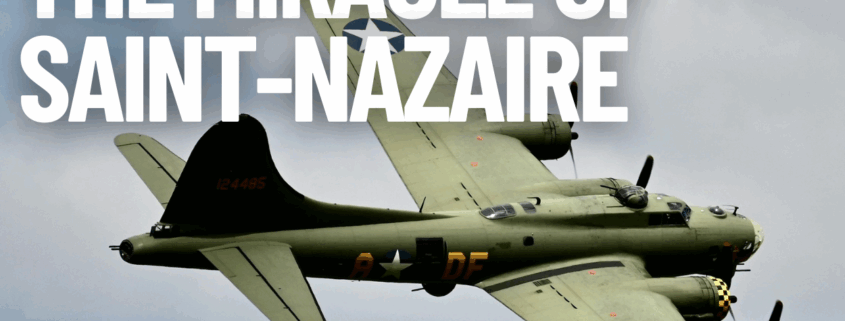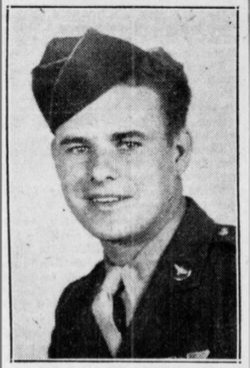|
Getting your Trinity Audio player ready...
|
In 2016, my lifelong passion for World War II history led me to Saint-Nazaire, a coastal town in western France. At the time, I was already traveling across the country to locate and acquire U.S. World War II artifacts—mostly personal belongings—with the goal of donating these significant items to museums across the United States. During that journey, I met a local historian named Pierre. We spent an entire afternoon talking about the war. That’s when I first heard the name of Staff Sergeant Alan Eugene Magee—a name I would never forget.
During World War II, the skies over Europe were a brutal battleground where death and devastation were constant companions. Day after day, countless Allied airmen climbed into their bombers, fully aware they might never return from their missions. In total, more than 26,000 members of the U.S. 8th Air Force were killed in combat, and over 47,000 were wounded. The average life expectancy for a bomber crew was less than 15 missions.
On January 3, 1943, all signs pointed to Staff Sergeant Alan Magee’s name joining the long casualty lists drawn up after each mission over Nazi-occupied territory. But what happened instead defied all logic and reason. This extraordinary tale became one of the most remarkable stories to emerge from the chaos of World War II.
On that fateful day, Magee—a 24-year-old ball turret gunner from Plainfield, New Jersey—was aboard a B-17 Flying Fortress nicknamed Snap! Crackle! Pop! During a daylight bombing run over the German-occupied port city of Saint-Nazaire, France, his aircraft was hammered by relentless German anti-aircraft fire. The ball turret, where Magee was stationed, had been rendered inoperable, so he rushed to retrieve his parachute. But before he could reach it, another round of enemy fire tore through the plane, and an explosion sent Magee tumbling into the open sky. As the ground fell away, Magee had one thought—a desperate plea that revealed the fear and uncertainty consuming him: “I don’t wish to die because I know nothing of life.”
The 22,000-foot fall was long, terrifying, and unforgiving. Magee plunged through the sky at a harrowing speed, his life flashing before him. Each second stretched endlessly as he descended, powerless to stop the inevitable. But fate had one miraculous twist in store for him. As he fell, Magee smashed through the glass roof of the Saint-Nazaire railroad station, shattering the surface and plunging to the ground. The glass helped to dissipate the force of his fall, cushioning his impact just enough to save his life.
When the Germans arrived at the scene, they couldn’t believe their eyes. The American airman, seemingly sent by some otherworldly force, was still alive. Despite the unimaginable fall, Magee was still breathing, though gravely injured. He suffered 28 shrapnel wounds, a broken nose, fractured bones, a punctured lung, kidney damage, and his right arm was nearly torn off. His injuries were horrific, but the very fact that he survived a 22,000-foot fall was nothing short of a miracle.
The German soldiers who found Magee were stunned. In a war where life often hung by a thread, they couldn’t fathom how the young airman had survived. The medical care that followed was a reminder that even in humanity’s darkest hours, there was still room for compassion. Magee later expressed gratitude to the German military doctor who treated him, acknowledging the kindness and care he received during his captivity.
After his miraculous survival, Magee was taken as a prisoner of war. Despite his severe injuries, he endured the hardships of being a POW with a remarkable will to live. His injuries were grave, and his recovery was long and painful, but his spirit never broke. Magee’s strength—both physical and mental—allowed him to survive the remainder of the war. He was eventually liberated in May 1945, and upon his return to New Jersey, he was awarded the Purple Heart and the Air Medal for his bravery and service. Following the war, Magee earned his pilot’s license and worked in the airline industry in a variety of roles. He retired in 1979 and moved to northern New Mexico.
While Magee’s survival was a miracle, it was also a tragedy. The other members of his crew—First Lieutenant Arthur I. Adams, Second Lieutenant Michael L. Libonati, Second Lieutenant Gene A. Witterstetter, Technical Sergeant Dennis C. Hart, Technical Sergeant Alfred M. Union, Sergeant Marvin L. Milam, and Staff Sergeant Edward W. Durant—did not survive the bombing raid. Their deaths were a heartbreaking reminder of the price of freedom, and Magee, the lone survivor, carried the weight of that loss with him for the rest of his life. In 1993, on the 50th anniversary of his fall, Magee returned to Saint-Nazaire to inaugurate a memorial to honor his fallen crewmates. The memorial, a six-foot-tall tribute, was erected by the grateful people of Saint-Nazaire, who had long honored both the miracle of Magee’s survival and the sacrifice of his crew. The town, deeply moved by Magee’s incredible story, ensured that their memory would never fade.
Amazingly, Alan Magee was not the only airman to survive a miraculous fall without a parachute during World War II. British Flight Sergeant Nicholas Alkemade, a tail gunner in the Royal Air Force, experienced a similarly incredible ordeal. On March 24, 1944, his Lancaster bomber was struck by German flak and caught fire, rendering his parachute unusable. Surrounded by flames, Alkemade chose to jump from about 18,000 feet, preferring a quick death to being burned alive. Incredibly, he landed in a pine tree and deep snow, which broke his fall and saved his life. He emerged with only a sprained leg—another astonishing case of survival against impossible odds.
Alan Magee passed away on December 20, 2003, in San Angelo, Texas, at the age of 84. The story of the Miracle of Saint-Nazaire will forever be remembered as a moment when fate, chance, and the power of human strength converged in the most unlikely of ways. It serves as a reminder that even in the most unimaginable circumstances, miracles can still happen—and that sometimes, even when all hope is lost, life finds a way.
I will always remember the first time I visited the old Saint-Nazaire railroad station—the very place where Alan’s miraculous fall occurred. The station was closed in 1955, and the glass roof is long gone, but the station building itself remains unchanged. Since 2012, it has been repurposed as the Saint-Nazaire Theater. I remember standing there, gazing up at the sky, picturing that American hero emerging from the clouds, and promising myself that I would do everything I could to keep his extraordinary story alive.
- The Miracle of Saint-Nazaire - August 13, 2025






John, Wow, just WOW! What a story and thank you for sharing it with us. I previously wrote abut my late father in law and his experience as a B-17 Top Turret gunner. It was the first submission I made to Air Facts.
You can read it here: https://airfactsjournal.com/2021/03/the-story-of-a-winged-boot-and-the-men-who-wore-it/
Good morning, Dale,
Thank you so much for your kind words. The story of S.Sgt Alan Magee is truly fascinating.
I’ve just read your moving article about your father, “The Story of a Winged Boot, and the Men Who Wore It”. What a beautiful and heartfelt tribute. Every word resonated deeply with me, and I was completely absorbed from beginning to end. Absolutely extraordinary. Thank you for sharing such a meaningful story.
Kindest regards from France,
John
John Dekhane,
I just finished reading your amazing story about the miracle fall of S.Sgt. Alan Magee. I must say while reading the story my heart was pounding with fear while imagining such a horrible fall. This was written beautifully and is such an amazing story of survival and strength. I thank you for remembering, S.Sgt Alan Magee and British Flight Sgt. Nicholas Alkemade. God bless ♡
Good morning, dear Eileen,
Thank you so much for your kind and thoughtful words.
I’m really pleased that my article resonated with you and brought S.Sgt. Alan Magee and British Flight Sgt. Nicholas Alkemade’s incredible courage to life.
Their service, devotion and survival are truly remarkable, and it means a lot to me that their stories continue to inspire others.
Thanks again, Eileen.
God bless you.
Kindest regards from France,
John
“Magee tumbling into the open sky. As the ground fell away, Magee had one thought….”
I don’t get it—“the ground fell away?”
That was my reaction too. I don’t think that is how gravity works.
The ground would be the surface he was standing on in the airplane!
Don’t forget when you quote the number of casualties of bomber crews, the North African based bombers…Thanks, Great story!
Thank you for sharing these incredible stories of two of the thousands who fought during that unimaginable time in history!
Apparently the Germans who came across Flight Sgt. Nicholas Alkemade thought he must be a spy, given his pretty unbelievable situation. They took a lot of convincing not to shoot him!